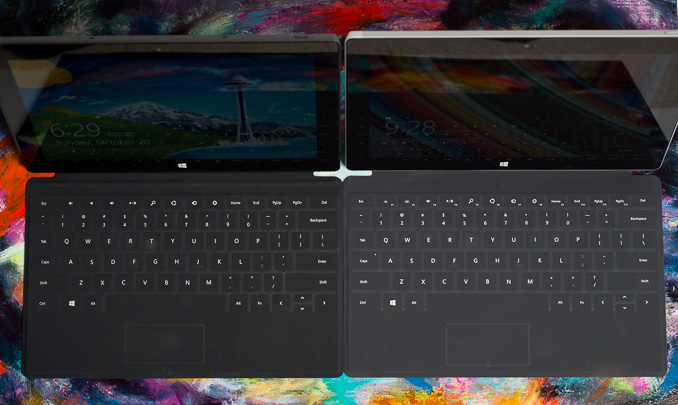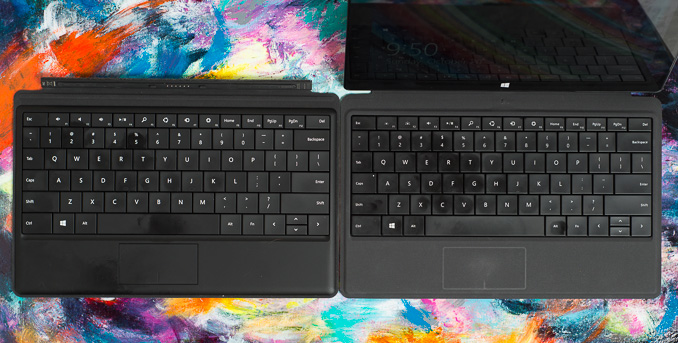Microsoft Surface 2 Review
by Anand Lal Shimpi on October 21, 2013 12:00 AM ESTThe New Touch/Type Covers
When I was first introduced to the folks who built Surface I was told about the three non-negotiable parts of its design: the tablet, the kickstand and the cover. While most tablet covers end up being protective accessories, the first party covers for Surface are an integral part of the overall experience.
Microsoft offers two cover options: the touch cover and the type cover. Both integrate full qwerty keyboards into a display cover that attached magnetically, but they differ in keyboard type. As its name implies, the touch cover integrates a pressure sensitive keyboard with no moving parts. By comparison, the type cover uses keys that physically move. Neither accessory is included with any Surface device and will set you back $119 for the touch cover and $129 for the type cover. They are expensive, but absolutely worth it if you’re going to do any sort of typing on your Surface.

Old (left) and new (right) touch covers
With the second generation of Surfaces, Microsoft improved both covers. They both get marginally thinner and backlit keys. The backlight effect is great, although there are only three keyboard backlight brightness levels.
The touch cover sees the biggest improvement as Microsoft moved from having only 80 pressure sensors in the previous design to 1092 sensors. The result is an incredible increase in accuracy. I find that I can type a lot lighter on the new touch cover and still have my keystrokes recognized. I also make far fewer mistakes on the new touch cover. While I felt that the initial touch cover was usable, this one is almost good enough to be a physical keyboard replacement.
| 2nd Generation Touch/Type Cover Thickness | ||||||||||
| Touch Cover | Type Cover | |||||||||
| 1st gen | 3.35 mm | 5.7 mm | ||||||||
| 2nd gen | 2.91 mm | 5.22 mm | ||||||||
| iPad 4 Smart Cover | 2.2 mm | |||||||||
Despite the tremendous improvement in accuracy on the new touch cover, I still prefer the type cover. I wrote long segments of this review on the new touch cover, but I had a much better time doing so on the type cover. Microsoft has reduced thickness on the new type cover, in part by reducing key travel. I’m happy to say that the reduction in key travel isn’t noticeable, and I’m able to type just as quickly and as comfortably as I could with the first gen type cover. The difference in thickness between the two is very small (~2.3mm) and you get a much more usable keyboard out of the type cover.

Old (left) and new (right) type covers
The new type cover ditches the clickpad in favor of a pressure sensitive trackpad. I’m a bit happier with the new trackpad but it’s still largely a pain to use for anything other than basic mousing. Two finger scrolling works ok, but any click and drag use is seriously frustrating thanks to the small size of the unit and no physical buttons. Thankfully there’s a 10.6-inch touchscreen a few inches away from you that works a lot better.
The new type cover ditches the felt backing of the previous model in favor of a soft touch plastic. Type covers are also now available in four colors (purple, pink, blue and black).
Remember that both of these covers make a physical connection to Surface, both to stay attached to the device as well as to transmit data. There’s no chance of running into spectrum crowding issues like you would with a 2.4GHz wireless keyboard, these keyboards are as good as any other wired device. The covers make a very strong magnetic connection to the device. The connection is strong enough to withstand picking up even a Surface Pro 2 by the attached cover and lightly swing it back and forth without the two separating. This is of course predicated on you properly attaching the cover to the tablet, but the strong magnets do a fairly good job of lining up and doing that as well.
The only issue I had with the new covers is that sometimes the trackpad would stop working after coming out of sleep. The keyboard worked fine, but the trackpad would just disappear. The only solution is to disconnect/reconnect the cover, which fixed it every time. I informed Microsoft about the issue, it’s something they’re aware of internally and plan to issue an update to fix.










139 Comments
View All Comments
Qwertilot - Monday, October 21, 2013 - link
Closest competitor would be something like that Transformer book T100, which is seemingly 349 in its cheapest form, keyboard included. Yes S2 is nicer in a few ways so you could justify a relatively modest premium but nothing enormous.I don't actually think the iPad/this stuff are in direct competition. Optimised for fairly different sort of uses.
tipoo - Monday, October 21, 2013 - link
Does typing cause such load with the touch cover, or type cover too? If it's just the touch, I wonder how much that impacts battery life? Seems like regular keyboard typing shouldn't produce that much load.Bummer that the Sunspider browser performance doesn't bear out anywhere else, I had hoped they pulled some crazy software wizadry to beat the A7 even with a slower SoC. Also makes me question how Intel showed off BT on IE11 to prove the A7 nearing it was just a matter of browsers, if IE11 just optimizes for sunspider. It still is a very fast browser though. I don't even mind using it, if not for lack of third party extensions.
Daniel Egger - Monday, October 21, 2013 - link
Actually I suspect that most of the performance improvements are due to Windows RT 8.1 vs. 8.0 the original Surface RT was tested with. I've updated mine and it feels a lot faster (though it also has plenty of new bugs, especially in IE with flash videos). However I wonder why the article mentions the lack of speed of the Surface RT a couple of times but the bars in the graphs are missing. Also I'd like to suggest to retest the old RT with 8.0 and 8.1 and put those 2 extra bars in.domboy - Monday, October 21, 2013 - link
"Without opening up classic desktop APIs to developers, we won’t see alternative web browsers like Chrome or Firefox on Windows RT 8.1 either....
I can understand Microsoft’s hesitation on this front (better control over the platform if you don’t open it up), but I can’t see a future where Windows RT is successful and Microsoft doesn’t allow developers to access both sides of the platform."
Thank you!! This is unfortunately the real problem with Windows RT. Lots of people have said this same thing in forums, but maybe Microsoft will actually listen when Anand Lal Shimpi says it. I love my Surface RT, but the lock on the desktop APIs is going to be the doom of this OS. Why bother with it (customer or developer) when Intel tablets are going to be the same price, the same battery life, and able to do so much more? The Surface RT/2 hardware is REALLY nice, but the OS is a sad tale... and the "jailbreak" for RT 8.0 just further proves this point.
isaacsou - Monday, October 21, 2013 - link
PLEASE PLEASE!Use also the metric system in the articles/reviews!!!
The readers outside US doesnt know (and dont want to know) what a lib or inch means!
Just put in parenthesis on the side
Thanks!
A5 - Monday, October 21, 2013 - link
2.2 lb = 1 kg1 inch = 2.5 cm
They're not hard conversions, and you should memorize them if you're going to read a lot of American websites.
MarcSP - Tuesday, October 22, 2013 - link
Anadtech.com is a pretty technical website that wants to be (is) international. It is only logical to use international units besides the local ones. I don't think that it would be a drawback for anyone. In what grounds would you oppose?Please Anandtech, do it! :-)
MarcSP - Tuesday, October 22, 2013 - link
Even Engadget does it! (And they put international units first. See: http://www.engadget.com/2013/10/22/ipad-air-ipad-m...azazel1024 - Monday, October 21, 2013 - link
Yes, if this had a Baytrail in it, it would be a must buy for me.That said, the price would still be too high. $549 for 64GB PLUS having to spend money on the touch cover puts the price wayyyy too high. That is, what? around $670 for the thing plus touch cover?
Nah ah.
If the touch cover were included, and it had a z3770 in it and 3 or 4GB of memory (keeping in mind that Windows 8.1 32-bit is the only connected sleep supporting version of Windows right now) and the price was $549, then I'd probably buy it in a heart beat.
Maybe I don't speak for most, but I feel like $500 is generally more or less the ceiling on what I'd ever consider spending on a tablet. Above that it is getting too close to ultrabook territory. Yes they are still vastly different devices, but looking at the Surface 2, tossing in another $200 and you can find many examples of very good 11.6-13 ultrabooks in that price range with very good hardware, screens, etc and vastly faster CPUs and GPUs in them.
Tablets by and large are content consumption devices with some minor productivity work. A dock (T100) or type cover (Surface 2) help out with that minor productivity work a lot. However, at roughly $670 for the "kitted out" Surface 2, its too expensive to replace a low end 11.6" ultrabook (more expensive than a number of them) and it doesn't work as well for the productivity bit. If you mostly want it for content consumption...sure the screen is nice, but I don't think it beats out most of the $300-500 10" android tablets, nor does it beat out something like the T100 by much (in terms of being spiffy for content consumptioN)...and NOT by more than 50% extra cost.
I think that is the issue that MS is going to continue having. Windows RT is just damned limited and the hardware is nice, but with the price and the limitations of RT it just isn't compelling.
At $50 less with a free type cover included and it might be in the compelling zone for a lot of people, but it isn't.
azazel1024 - Monday, October 21, 2013 - link
I can't speak to skydrive, as I haven't touched in since I upgraded to 8.1 yesterday. However, in upgrading I found two things.Yes, it requires a Microsoft account. Stupid, but it does. Once you upgrade, you can "downgrade" the microsoft connected account, to a local account again. Its under the metro settings for user accounts. Find the user account and if you poke around in the settings there is an option to change it to a local account. It gets pissy with you trying to do it, but it WILL let you do it.
Next, Lucid Logix Virtu MVP does not work under Windows 8.1. Or at least it doesn't work with my AMD 5670 and i5-3570. 8.1 upgraded fine, but after initial boot it cratered after 60 seconds and then boot cycled everytime it finished loading and was about to bring up the start screen. I managed to boot to safe mode fine, on a lark I tried reinstalling Virtu MVP. I then booted as normal just fine. It finished installing Virtu MVP and then proceeded to flash the BSOD for about 200ms and then boot cycled again.
Nothing I have tried (other than uninstalling it and running with either just the dGPU or iGPU) has worked.